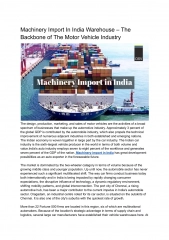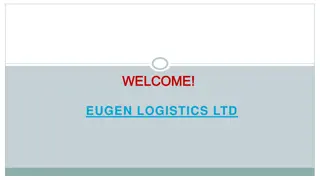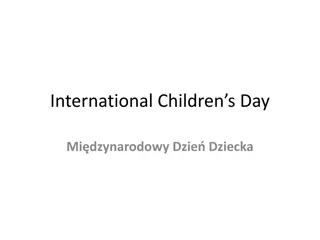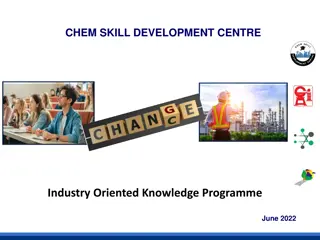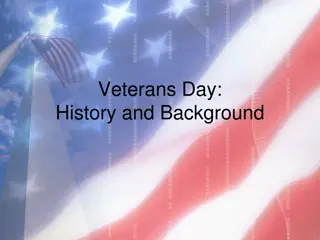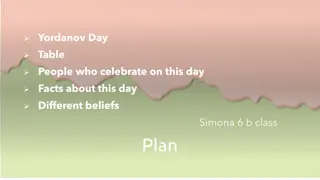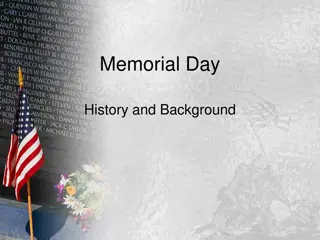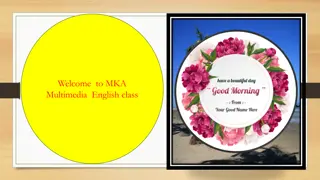
LOGHOUSE.II Program Overview and Capabilities for Housing Operations
This document outlines the details of the LOGHOUSE Part II program, including industry day agenda, project overview, contracting process, and key housing assistance programs. It covers information on housing units, maintenance, site inspections, training, and collaborations beneficial for mission preparedness. The content showcases images related to the logistics housing operations, temporary housing units, and readiness training. Federal Emergency Management Agency (FEMA) plays a significant role in facilitating these operations.
Download Presentation

Please find below an Image/Link to download the presentation.
The content on the website is provided AS IS for your information and personal use only. It may not be sold, licensed, or shared on other websites without obtaining consent from the author. If you encounter any issues during the download, it is possible that the publisher has removed the file from their server.
You are allowed to download the files provided on this website for personal or commercial use, subject to the condition that they are used lawfully. All files are the property of their respective owners.
The content on the website is provided AS IS for your information and personal use only. It may not be sold, licensed, or shared on other websites without obtaining consent from the author.
E N D
Presentation Transcript
LOGHOUSE II Industry Day July 12, 2022
AGENDA ANNOUNCEMENTS (Ashlee Young) 5 minutes WELCOMING REMARKS (Peter Camit) 10 minutes LOGHOUSE II PROJECT OVERVIEW (Shunte Gray/Matthew Rabkin) 30 minutes CONTRACTING PROCESS (Allison Brazzel) 15 minutes QUESTIONS/OPEN DISCUSSION CLOSING REMARKS Federal Emergency Management Agency 2
Logistics Housing Operations Unit Installation, Maintenance and Deactivation (LOGHOUSE) Part II Program Overview by Matthew Rabkin and Shunte Gray
Direct Housing Program Section 408 of the Robert T Stafford Act Four Types of Housing Assistance Temporary Housing Transportable Temporary Housing Units Manufactured Housing Units Travel Trailers Repairs Replacement Permanent Housing Construction (CONUS when MHUs are used) Federal Emergency Management Agency 4
Transportable Temporary Housing Units (TTHUs) Manufactured Housing Units (MHUs) Next Generation (NextGen/Universal) FEMA Standard design 14 ft 1-bedroom, 1-bedroom and 3-bedroom Units 8 ft 1-bedroom express COTL MHUs Travel Trailers (TTs) COTL TT FEMA UFAS (Under development) Federal Emergency Management Agency 5
LOGHOUSE Part II Capabilities Site Inspection Reports (SIRs) and Feasibility Determinations Staging Yard Design, Construction and Operation Haul (Transportation) and Install (Installation) of TTHUs Maintenance Monthly Preventative Maintenance Inspection and Repairs (PMIRs) Emergency Maintenance Minor and Major Repairs Deactivation (Uninstallation and Removal) Design and Construction Activities Group Sites and Emergency Group Site (EGS) Commercial Park Expansion Federal Emergency Management Agency 6
LOGHOUSE Readiness Training Badging Readiness Deliverables White Papers Training Videos Annual LOGHOUSE Conference Other Collaborations that the vendors and FEMA would find beneficial for TTHU housing mission preparedness Federal Emergency Management Agency Federal Emergency Management Agency 7
LOGHOUSE Acquisitions Base Contract Multiple Award Indefinite Delivery Indefinite Quantity (IDIQ) Fair Opportunity to Compete Task Orders awarded Combination of Large and Small Business OCONUS only All Contractors National Haul and install National Maintenance and Deactivation Construction Small Business Set-Aside Federal Emergency Management Agency 8
LOGHOUSE Part II Install procedures to mirror HUD requirements (Manufactured Homes) Provide standardize reports Incorporate travel trailer requirements Design Appendix for group sites and commercial park expansion Incorporate Emergency Group sites Standardize travel requirements in line with Federal Travel Regulations Incorporation of Next Generations Requirements Stricter Readiness Requirements Federal Emergency Management Agency 9
CONTRACTING PROCESS Allison Brazzel
FEDERAL GOVERNMENT CONTRACTING PROCESS 1. Market Research 2. Solicitation Type 3. Solicitation Evaluation 4. Best Practices Before Submitting a Proposal 5. ContractAward 6. ContractAdministration Federal Emergency Management Agency 11
FEDERAL GOVERNMENT CONTRACTING PROCESS 1. Market Research Sources Sought (Request for Information) Asks for industry comments or provide notice that a solicitation is planned. This is your opportunity to let us know your capabilities or provide your professional input. Pre-Solicitation Notices For most requirements, a pre-solicitation notice is published a minimum of 15 calendar days before the solicitation is published; however, it can be months or even years depending on the scope of the project. Federal Emergency Management Agency 12
FEDERAL GOVERNMENT CONTRACTING PROCESS 2. Solicitations Most solicitations are advertised on for a minimum of 30 days at https://www.sam.gov Amendments are changes to the solicitation. Amendments often answer questions, clarify the work to be performed, or correct errors in the solicitation. Amendments also may extend the due date of the offer. You must acknowledge each amendment when submitting your offer to confirm that you are offering on the most recent version of the work to be performed. Federal Emergency Management Agency 13
FEDERAL GOVERNMENT CONTRACTING PROCESS 2. Solicitation Type Type: Request for Proposal (RFP) is used to communicate government requirements to vendors and solicit proposals. The basis for award is either: Lowest Price Technically Acceptable (LPTA) award to the responsible offeror with the lowest priced, technically acceptable proposal Trade-off Process award to the responsible offeror with a proposal that provides the best value to the Government. May or may not be the lowest price. Federal Emergency Management Agency 14
FEDERAL GOVERNMENT CONTRACTING PROCESS 3. Solicitation Evaluation Evaluation Factors: Technical, Past Performance, Small Business Participation and Price Rating of non priced factors: LPTA: Acceptable or Unacceptable Trade-off: Outstanding, Good, Satisfactory, Marginal, & Unsatisfactory Responsibility Check Federal Emergency Management Agency 15
FEDERAL GOVERNMENT CONTRACTING PROCESS 4. Best Practices Before Submitting a Proposal Read and download all associated attachments posted with the solicitation Understand Provisions, Terms and Conditions cited within the solicitation Check price calculations on Pricing Schedule Follow proposal submission instructions Address ALL evaluation factors Offer precisely what is asked for Federal Emergency Management Agency 16
Discussion If you have worked on the current LOGHOUSE contract, what, if any, suggestion do you have to improve the task order proposal request/award process and administration of the task orders? What would FEMA need to do or change to increase the chances of your company submitting a proposal for LOGHOUSE II? What specific type of activities or exercises do you suggest that FEMA conduct to support a readiness posture? Federal Emergency Management Agency
Angelina Bachemin Contract Officer Ashlee Young Contract Specialist fema-loghouse-contracting@fema.dhs.gov




